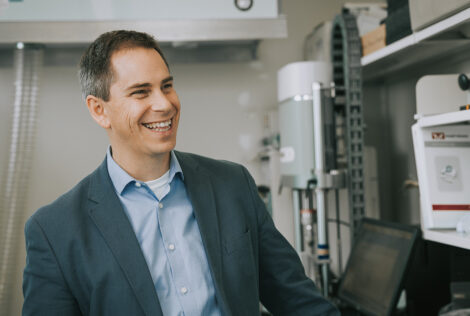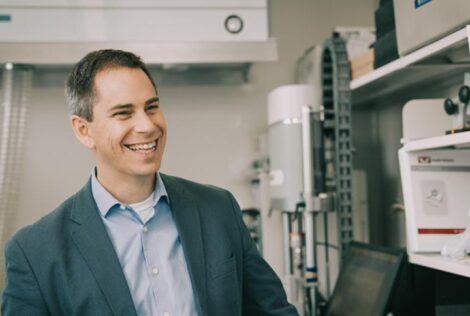
Expertise
Biomechanics
Areas of Specialization
Research Clusters
-
Department Chair
Mechanical Engineering
-
Associate Professor
Mechanical Engineering
-
Associate Professor
Integrated Biomedical Engineering & Health Sciences
Overview
Specific Research Activities
The following items summarize my main research interests:
- Biomechanics of Musculoskeletal Systems
- Bone Adaptation to Mechanical Stimuli and Injury
- Effects of Mechanical Loading, Growth, Disease, Injury, Pharmaceutical therapies, and diet on Bone Mechanics and Mechanical Behaviour
- Interface Behaviour Between Tissues and Surgical Instruments / Surgical Robotics
As part of my research, I am interested in the biological mechanisms that mediate bone formation in response to loading and injury. Mechanical stimuli (e.g., exercise) can induce bone formation (osteogenesis). Osteogenesis in response to moderate bone loading results in a highly organized, anisotropic, “lamellar” bone structure that can modestly increase bone structural strength. In comparison, osteogenesis in response to mechanical fatigue injury and stress fractures can take the form of disorganized “woven” bone. In athletes and soldiers, long distance running or marching causes a cyclic loading of bones in the foot and leg and can induce fatigue damage including formation of cracks in the bone matrix. Unlike endochondral bone formation in fracture repair, which forms by calcification of an initial cartilage callous, the woven bone following fatigue injury is intramembranous in nature and forms rapidly without the need of a callous. Although the woven bone is a relatively “poor” material, the repair process is much faster than lamellar bone formation, and structural integrity of the bone can be rapidly restored. Molecular biology techniques such as quantitative real-time polymerase chain reaction (RT-qPCR) and in-situ hybridization are used to characterize gene expression associated with bone biological repair following mechanical loading and fatigue injury. The influence of genes on bone repair will be further explored by inhibiting molecular pathways (e.g., angiogenesis or Hedgehog signalling), and using transgenic or conditional knock-out models. Understanding the molecular mechanisms of bone adaptation will serve as a basis for development of novel strategies to enhance tissue engineering and the development of therapies to promote bone formation in patients at risk for skeletal fragility fractures.
I am also interested in the role of nutrition on bone adaptation. For example, dietary fatty acids can affect the mechanical properties of bone and can also alter the ability of bone cells to respond to mechanical stimuli through activation of synthetic molecules (e.g., prostanoids). Prostaglandins (PGs) play a role in bone formation and remodelling and are synthesized through cyclo-oxygenase-2 (Cox2) from fatty acids stored locally in the cells. Diet can influence the type of fatty acids stored in the cells. The consumption of saturated fatty acids (e.g., from animal fats) can alter the cellular balance of unsaturated fatty acids such as n-3 (e.g., fish oils) and n-6 (e.g., soybean and sunflower oils), and can impair the production of prostaglandins in response to injury or mechanical stimuli. High-fat diets of Western cultures with an emphasis on saturated fats may play a role in increased incidence of age-related metabolic bone disease (e.g., osteoporosis). In the ageing skeleton, an inhibited cellular response to mechanical loading might exacerbate the age-related decline in bone mass and contribute to skeletal fragility.
Keywords: biomechanics, bone, adaptation, molecular biology, nutrition
- B.Sc., University of Calgary, 1991
- M.Sc., University of Calgary, 1996
- Ph.D., University of Calgary, 2002
- President’s Award for Outstanding Contributions to Teaching and Learning (2015-2016)
- McMaster Students Union (MSU) Teaching Award (201
- An R, Khadar GW, Wilk EI, Emigh B, Haugen HK, Wohl GR, Dunlop B, Anvari M, Hayward JE, Fang Q. Ultrafast laser ablation and machining large size structures on porcine bone. Journal of Biomedical Optics. 18(7):070504. (doi:10.1117/1.JBO.18.7.070504)
- Wohl GR, Chettle D, Pejović-Milić A, Druchok C, Adachi JD, Beattie K. Accumulation of bone strontium measured by in vivo XRF in rats supplemented with strontium citrate and strontium ranelate. Bone 52 (1): 63-69, 2013 (doi: 10.1016/j.bone.2012.09.002)
- Tomlinson RE, McKenzie JA, Schmieder AH, *Wohl GR, Lanza GM, Silva MJ. Angiogenesis is required for complete stress fracture healing in rats. Bone 52 (1): 212-219, 2013 (doi: 10.1016/j.bone. 2012.09.035) *[30% technical contribution, 10% writing and editing]
- Emigh B, An R, Hsu EM, Crawford THR, Haugen HK, 3Wohl GR, Hayward JE, Fang Q. Porcine cortical bone ablation by ultrashort pulsed laser irradiation. Journal of Biomedical Optics. 17(2):028001, 2012. (doi: 10.1117/1.JBO.17.2.028001)
- Rezai P, Selvaganapathy PR, Wohl GR. Plasma Enhanced Bonding of Polydimethylsiloxane (PDMS) with Parylene and its Optimization. Journal of Micromechanics and Microengineering. 21(6):65024-65036, 2011. [IF: 2.281]
- 1Wohl GR, Towler DA, Silva MJ. Stress fracture healing: Fatigue loading of the rat ulna induces upregulation in expression of osteogenic and angiogenic genes that mimics the intramembranous portion of fracture repair. Bone 44 (2): 320-330, 2009.
- Matsuzaki H, Wohl GR, Novak DV, Lynch JA, Silva MJ. Damaging fatigue loading stimulates rapid increases in vascularity at sites of bone formation in the rat ulna. Calcified Tissue International. 80(6): 391-399, 2007.
- Antolic A, Roy BD, Tarnopolsky MA, Zernicke RF, Wohl GR, Shaughnessy SG, Bourgeois JM. Creatine monohydrate increases bone mineral density in young Sprague-Dawley rats. Medicine and Science in Sports and Exercise . 39: 816-820, 2007
- Silva MJ, Uthgenannt BA, Wohl GR, Rutlin JR, Lewis JS, Welch MJ. In vivo skeletal imaging of 18 F-fluoride with positron emission tomography reveals damage- and time-dependent responses to fatigue loading in the rat ulna. Bone 39: 229-236, 2006
- Gittens S, Wohl GR, Zernicke RF, Matyas JR, Morley P, Uludag H. Systemic bone formation with weekly PTH administration in ovariectomized rats. Journal of Pharmacy and Pharmaceutical Sciences 7: 27-37, 2004
- Doschak MR, Wohl GR, Hanley DA, Bray RC, Zernicke RF. Antiresorptive therapy conserves periarticular bone and ligament mechanical properties after anterior cruciate ligament disruption. Journal of Orthopaedic Research 22: 942-948, 2004.
- Pardy C, Wohl GR, Ukrainetz P, Sawyer A, Boyd SK, Zernicke RF. Maintenance of bone mass and architecture in denning black bears ( Ursus americanus ). Journal of Zoology ( London ) 263: 359-364, 2004.
- Wohl GR, Shymkiw RC, Matyas JR, Kloiber R, Zernicke RF. Periarticular cancellous bone changes following anterior cruciate ligament injury. Journal of Applied Physiology 91: 336-342, 2001.
- Muldrew K, Novak K, Studholme C, Wohl G, Zernicke R, Schachar NS, McGann LE. Transplantation of articular cartilage following a step–cooling cryopreservation protocol. Cryobiology 43: 260-267, 2001.
- Boyd S, Shrive N, Wohl G, Müller R, Zernicke R. Measurement of cancellous bone strain during mechanical tests using a new extensometer device. Medical Engineering and Physics 23: 411-416, 2001.
- Judex S, Wohl GR, Wolff RB, Leng W, Gillis AM, Zernicke RF. Dietary fish oil supplementation adversely affects cortical bone morphology and biomechanics in growing rabbits. Calcified Tissue International 66: 443-448, 2000.
- Schachar NS, Novak K, Hurtig M, Muldrew K, McPherson R, Wohl G, Zernicke RF, McGann LE. Transplantation of cryopreserved osteochondral allografts for joint reconstruction in an ovine model. Journal of Orthopaedic Research 17: 909, 1999.
- Wohl G, Goplen G, Ford J, Novak K, Hurtig M, McPherson R, McGann L, Schachar N, Zernicke R. Mechanical integrity of subchondral bone in osteochondral autografts and allografts. Canadian Journal of Surgery 41: 228-233, 1998.
- Wohl GR, Loehrke L, Watkins BA, Zernicke RF. The effect of high-fat diet on mature bone mechanical properties, structure, and mineral content. Calcified Tissue International . 63: 74-79, 1998.
- Book Chapter: Zernicke RF, Wohl GR, LaMothe J. “The Skeletal–Articular System.” In: ACSM’s Advanced Exercise Physiology Textbook . C. Tipton and T. Tate (eds.) Lippincott Williams & Wilkins, Philadelphia, PA, 2005.







